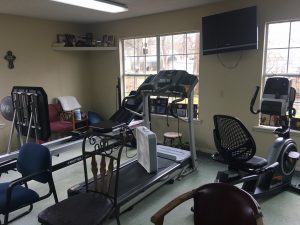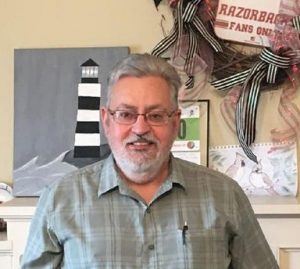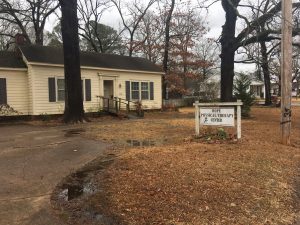“I HURT RIGHT THERE”- HOW LOCAL THERAPIST BUTLER HAS BROUGHT RELIEF TO MANY IN HOME-STYLE SETTING
By Scott Jester, 03/9/22 3:17 AM


If you weren’t really looking for it when driving north on Main Street here in Hope, you’re going to miss it on your first try.
“Hey wait! I think we passed it,” is surely said by many when looking for local longtime Physical Therapist Dean Butler’s therapy center.
In case one didn’t already know, it is located in a modest-looking home built in the 1930’s on the corner of 14th street and Main.
It has become so much a part of the background as we hustle and bustle on our daily adventures, but when you need him, you will definitely find it..
The house alone is another element to this story and we will get to it later.
According to the Journal of Physical Therapy Education, modern physical therapy somewhat evolved from three major historical events.
The polio epidemic that was first realized in the 1880’s, that then raged through the U.S. from the 1920’s through the 1930’s; and the attempts to aid the wounded from the ravages of two World Wars.
Marguerite Sanderson and Mary McMillan were noted as the first two individuals who trained “reconstruction aides”, caring for soldiers wounded in WWI.
Talk about a job. A very difficult and many times beyond-heartbreaking job. The horror of war.
Some early methods of treatment for those with Polio, which severely affected the muscles of millions, were isolation, immobilization, splinting, bed rest, and many times surgery. It was the best one could do as physicians wrestled with a cure.
Much as the caveman discovered fire, through trial and sometimes error, the United States quickly made great strides during World War II in establishing national “acts” to ensure technics and methods that aided in recovering injured soldiers back then, and today, well, you’ll understand if you keep reading.
Say hello to Dean Butler, a most friendly fellow with a warm greeting upon our meeting on a cold day for a tour of the therapy center and some education of his view on physical therapy.
Sitting down, we initially discussed distance running a bit while relating my wife’s 35-year road running career which has taken some toll on her and he, being much wiser, ran one marathon, competed in a few select races and hung it up, medals and all still inside his therapy center before the pounding of the road took its toll on him.
“I was born in Hempstead County Memorial right here on Main Street in 1958,” Butler states as someone who is a true son of Hope and Hempstead County.
“Daddy was from Spring Hill and Momma was from DeAnn. He was a small farmer and she worked at various places around here.
“I graduated from Hope High in 1976 and then graduated from UCA which was the only school with a Physical Therapy program at the time.”
Butler began considering physical therapy in high school after talking to one of the teachers who approached him and a longtime caring local doctor who opened the door to his career.
“Thank goodness there was a teacher in high school when I was a Junior who guided me that way and she said I ought to try it.
“Dr. Lowell Harris arranged for me to go visit a physical therapist in Texarkana because there wasn’t one in Hope. Dr. Harris was very busy and but still made time to help people out,” Butler said.
And for readers who grew up here and knew Dr. Harris can confirm Butler’s description of the well-respected and fondly remembered physician. He was a wonderful man and his wife Charlene is still here with us and a wonderful person as well.
“In college I thought about other education choices but stayed on with this and it has worked out well,” says a man who put in long hours and studied and practiced his craft for more than 40 years.
“At that time it was about a four-and one-half year program,” Butler continued. “We went to college for three years and if you got accepted to the physical therapy program, which wasn’t a done deal, then it was a continuous program through spring and fall with no breaks,” (no pun intended).
And from college, it was back to Hope, Arkansas, his hometown, to face the future.
“The hospital here in February 1980 needed a therapist so, I started a physical therapy department there and later set up the physical therapy office in the new hospital, (Medical Park),” said Butler.
“I saw an opportunity to work for myself after about three years and rented a place across town and then came across this house.
“I fell in love with it. I liked its old charm.”
But there was more to the decision of moving his practice into this well-seasoned house. It had certainly seen a lot in its previous years, but when you walk inside, it’s like slipping into a pair of old, comfortable jeans.
Many rooms make up the home which are converted into exam or treatment rooms with one great room that had been added on years ago to serve as a room where many of the therapies take place.
While being less threatening than any large complex, Butler states, “It’s a “homey” atmosphere.
“I didn’t like going to the doctors, like most men, I looked at it like it was just so sterile and everyone was wearing masks and such, of course we still do wear masks and gloves when needed, especially with COVID, but it’s more relaxed and inviting.”
Butler is quick to mention his great staff and associates including Assistive Physical Therapists, Kevin Fuller and Jeff Oakley.
All three therapists are able to take care of this area’s needs. Another local blessing without having to travel many miles to be served.
“Mostly we see orthopedic patients, but sometimes we see stroke patients,” Butler says.
“Just like a small-town, family practice doctor, where he has to see just about everything.
“It’s post-surgical knees and shoulders that are number one in the cases we see,” Butler continues on which type patient he sees most.
“After that it’s backs that probably ranks third ahead of the hand, ankle or foot.” Most all are therapies prescribed by local physicians.
What about the now exploding Baby Boomer generation? Is there a predominant age that is primarily seen these days?
“It’s a pretty wide span, but yes, we see a lot of Baby Boomers,” notes Butler. “They are having more knee, hip, and shoulder surgeries from wear and tear and being hard on their body for those years.”
Something to remember, because of the lack of some technologies of today, many men (and women) of the Baby Boomer generation worked standing much of their day, and usually on a concrete floor.
Do you know the damage that can do? Year, after year, after year?
A retired random shoe salesman of back then is needing surgery on his knees now. And, thankfully, the proper therapy to have that former salesman soon dancing a jig.
To folks of any age, a bit of friendly advice on following through with your therapy from Butler.
“How can you politely say ‘when you go to your doctor, do what he says,’” Butler laughed.
“People will tell us the ‘doctor ordered therapy, but I’m not coming,’. Ok, that’s your choice is all we can say, but not following through could result in a frozen shoulder, messed up knees and any joint can freeze.
“What is worse, many times, is the doctor has to go back in, do surgery again, ‘manipulate’ the area, and the patient is really going to hurt the next day,” Butler said as gently he could state
Let me help translate in terms many can understand.
WOULD YOU LIKE THE DOCTOR TO RE-BREAK YOUR SHOULDER AND START THIS ALL OVER AGAIN?!?
I didn’t think so.
The readers of this publication are much too wise about their own health to go against the advice of their doctor. Right?
Lastly, after 41 years of practice, what gets Dean Butler out of bed and to his place of work every day?
“It’s nice to help other people,” he modestly replies.
“Sometimes it’s a 20-year-old, or a 50-year-old, or an 80-year-old, but to see them make good progress, that’s something I really like. We can make a lot of difference in people’s lives.”
While the home/office was built almost a century ago and it has weathered the many storms that have blown through, she provides a warm and welcoming atmosphere, disarming many worried thoughts just upon entering her front door.
Inside the walls of that old house folks of all ages come in not knowing if their pain will EVER go away.
Will their hip or shoulder will work again? Will they walk again? All as they walk or wheel or hop their way into the front door of the Hope Physical Therapy Center.
But with patience, determination, faith and PHYSICAL THERAPY, we citizens of the area have active years added to our lives because of Dean Butler and his terrific staff.




